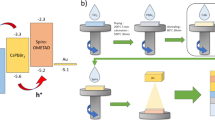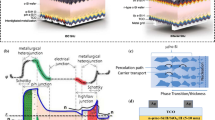Abstract
In the present work, a new process is reported to recover metallic contacts and wafer from the crystalline silicon solar cell through chemical etching. 2 M KOH was used as an etching solution at temperatures 110 ± 1 °C and 85 ± 1 °C. During the process, metallic contacts were extracted, without breaking, in the form of fingers and foils along with the silicon wafer. The contacts and recovered wafer were characterized through Scanning Electron Microscopy, Energy Dispersive Spectroscopy, X-ray fluorescence spectroscopy, X-Ray Diffraction, Electrochemical Capacitance Voltage Analysis, Four Probe Measurement technique, and Ultraviolet absorption spectroscopy. It was found that the recovered wafer is of P-type with 100 orientation and has a bulk resistivity of ~1 Ω cm with a dopant density of 2× 1016 – 4.5 × 1016 atoms per cm3. The recovered wafer thickness was found to be etching temperature-dependent. High processing temperature (110 °C) deteriorated the wafer resulting in deep groove formation on the front surface and led to decrement in wafer thickness. No grooves were observed in the sample treated at a lower temperature (85 °C), and the thickness was also not reduced too much. The recovered contacts were mainly composed of silver. Lead present on the back contact was removed during the process resulting in the recovery of silver contacts with a purity of ~99%. UV absorption spectroscopy confirmed the removal of lead in the form of lead(II) complex ion. The etching process also led to the complete removal of the p-n junction from the solar cells.
Similar content being viewed by others
Data availability statement
All data generated or analysed during the study are included in this article.
References
Photovoltaics Report. Accessed on 28th October 2021
States U, Agency IE (2020) Global PV capacity additions hit 115 GW in 2019, says IEA. 1–5
Gielen D, Boshell F, Saygin D et al (2019) the role of renewable energy in the global energy transformation. Energy Strategy Reviews 24:38–50. https://doi.org/10.1016/j.esr.2019.01.006
Padoan FCSM, Altimari P, Pagnanelli F (2019) Recycling of end of life photovoltaic panels: A chemical prospective on process development. Sol Energy 177:746–761
Tao J, Yu S (2015) Review on feasible recycling pathways and technologies of solar photovoltaic modules. Sol Energy Mater Sol Cells 141:108–124
Energy Agency I Technology Roadmap Solar Photovoltaic Energy - 2014 edition Accessed on 28th October 2021
Azeumo MF, Conte G, Ippolito NM et al (2019) Photovoltaic module recycling, a physical and a chemical recovery process. Sol Energy Mater Sol Cells 193:314–319. https://doi.org/10.1016/j.solmat.2019.01.035
Balaji N, C. Raval M, Saravanan S (2020) Review on Metallization in Crystalline Silicon Solar Cells. In: Solar Cells. IntechOpen
Chitra, Sah SD, Lodhi K et al (2020) Structural composition and thermal stability of extracted EVA from silicon solar modules waste. Sol Energy 211:74–81. https://doi.org/10.1016/j.solener.2020.09.039
Fields JD, Ahmad MI, Pool VL et al (2016) The formation mechanism for printed silver-contacts for silicon solar cells. Nat Commun 7. https://doi.org/10.1038/ncomms11143
Song BP, Zhang MY, Fan Y et al (2020) Recycling experimental investigation on end of life photovoltaic panels by application of high voltage fragmentation. Waste Manag 101:180–187. https://doi.org/10.1016/j.wasman.2019.10.015
Heath GA, Silverman TJ, Kempe M et al (2020) Research and development priorities for silicon photovoltaic module recycling to support a circular economy. Nat Energy 5:502–510. https://doi.org/10.1038/s41560-020-0645-2
Granata G, Pagnanelli F, Moscardini E et al (2014) Recycling of photovoltaic panels by physical operations. Sol Energy Mater Sol Cells 123:239–248. https://doi.org/10.1016/j.solmat.2014.01.012
Paiano A (2015) Photovoltaic waste assessment in Italy. Renew Sust Energ Rev 41:99–112
Strachala D, Hylský J, Vaněk J, et al (2017) Methods for recycling photovoltaic modules and their impact on environment and raw material extraction
Stephanie Weckend, Andreas Wade, Garvin Heath (2016) End of Life Management Solar PV Panels
Sykorova B, Lascar A, Vekony AT (2018) The Opportunities of Solar Panel Recycling What Happens to PV Panels When Their Life Cycle Ends. GreenMatch 1–10 Accessed on 28th October 2021
Ushasree PM, Bora B (2019) CHAPTER 1. Silicon Solar Cells pp 1–55
Frisson, L. (1998) Cost Effective Recycling of PV Modules and the Impact on Environment, Life Cycle, Energy Payback Time and Cost. 2^<th> World Conference and Exhibition on Photovoltaic solar energy conversion 2210–2213
Frisson L, Lieten K, Bruton T, et al Recent improvements in industrial PV module recycling
Klugmann-Radziemska E, Ostrowski P (2010) Chemical treatment of crystalline silicon solar cells as a method of recovering pure silicon from photovoltaic modules. Renew Energy 35:1751–1759. https://doi.org/10.1016/j.renene.2009.11.031
Wang TY, Hsiao JC, Du CH (2012) Recycling of materials from silicon base solar cell module. In: Conference Record of the IEEE Photovoltaic Specialists Conference. pp. 2355–2358
Park J, Park N (2014) Wet etching processes for recycling crystalline silicon solar cells from end-of-life photovoltaic modules. RSC Adv 4:34823–34829. https://doi.org/10.1039/c4ra03895a
Shin J, Park J, Park N (2017) A method to recycle silicon wafer from end-of-life photovoltaic module and solar panels by using recycled silicon wafers. Sol Energy Mater Sol Cells 162:1–6. https://doi.org/10.1016/j.solmat.2016.12.038
Dias P, Javimczik S, Benevit M et al (2016) Recycling WEEE: Extraction and concentration of silver from waste crystalline silicon photovoltaic modules. Waste Manag 57:220–225. https://doi.org/10.1016/j.wasman.2016.03.016
Savkina RK (2013) Properties of the crystalline silicon strained via cavitation impact
Arshi N, Ahmed F, Anwar MS et al (2011) Novel and cost-effective synthesis of silver nanocrystals: A green synthesis. Nano 6:295–300. https://doi.org/10.1142/S1793292011002743
Srirangam GM, Parameswara Rao K (2017) Synthesis and charcterization of silver nanoparticles from the leaf extract of Malachra capitata (L.). Rasayan J Chem 10:46–53. https://doi.org/10.7324/RJC.2017.1011548
Holzwarth U, Gibson N (2011) The Scherrer equation versus the “Debye-Scherrer equation”. Nat Nanotechnol 6:53
Speakman SA Estimating Crystallite Size Using XRD http://prism/mit.edu/xray. Accessed on 28th October 2021
Glunz SW, Preu R, Biro D (2012) crystalline silicon solar cells. State-of-the-art and future developments. In: Comprehensive Renewable Energy. Elsevier Ltd, pp. 353–387
Weng W, Brackmann C, Leffler T et al (2019) Ultraviolet Absorption Cross Sections of KOH and KCl for Nonintrusive Species-Specific Quantitative Detection in Hot Flue Gases. Anal Chem 91:4719–4726. https://doi.org/10.1021/acs.analchem.9b00203
Nimal Perera W, Hefter G, Sipos PM (2001) an investigation of the Lead (II)-hydroxide system. Inorg Chem 40:3974–3978. https://doi.org/10.1021/ic001415o
Acknowledgments
The authors are very thankful to the Director, CSIR-NPL, for their valuable support. The authors are also grateful to Dr. Vandana, Dr. Jai, and Mr. Naval Kishore for ECV analysis, SEM-EDS analysis, and XRD measurements. The authors (Dheeraj Sah and Chitra) would like to acknowledge CSIR for the JRF/SRF fellowship.
Funding
Authors Dheeraj Sah and Chitra received funding from the Council of Scientific and Industrial Research (CSIR) as JRF/SRF under grant no. 31/001(0530)/2019-EMR-I and 31/001(0516)/2018-EMR-I, respectively.
Author information
Authors and Affiliations
Contributions
Dheeraj Sah: Experimental work, writing manuscript draft.
Chitra: Assisted in experimental work and rearranging manuscript draft.
Kalpana Lodhi: Assisted in experimental work.
Chander Kant: Assisted in experimental work.
Sanjay K. Srivastava: Sample characterization.
Sushil Kumar: Conceptualization, review & editing, supervision.
Corresponding author
Ethics declarations
Research Involving human participants or animals
Not applicable.
Informed Consent
Not applicable.
Consent to participation
Not applicable.
Consent for publication
Not applicable.
Conflict of Interest
Authors declare no conflict of interest directly or indirectly related to the work submitted for publication.
Additional information
Publisher’s Note
Springer Nature remains neutral with regard to jurisdictional claims in published maps and institutional affiliations.
Rights and permissions
About this article
Cite this article
Sah, D., Chitra, Lodhi, K. et al. Extraction and Analysis of Recovered Silver and Silicon from Laboratory Grade Waste Solar Cells. Silicon 14, 9635–9642 (2022). https://doi.org/10.1007/s12633-022-01715-6
Received:
Accepted:
Published:
Issue Date:
DOI: https://doi.org/10.1007/s12633-022-01715-6




